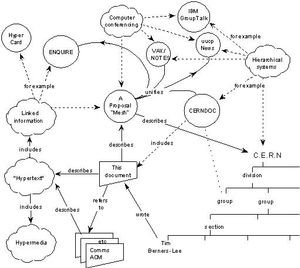World Wide Web
 a.k.a. the Web, WWW, web, Solid
a.k.a. the Web, WWW, web, Solid "The Web," as it is more commonly called, can be described as a collection of graphical pages on the Internet that can be read and interacted with by computer. You need an Internet connection, a computer, a Web browser, and a few specialized programs (listed below) in order to access and view this online information.
The Web actually exists as a global system of servers that supports specially formatted files written in a code that links them together. Many of the files contain graphics, audio, and/or video. The Web is a hypertext system that you navigate by clicking on links.
One thing that makes the Web such an exciting and useful medium is that the next document you "visit" could be located on a server down your block or on a server halfway around the world. Note: Not all Internet servers are part of the World Wide Web, but the Web requires the Internet as its transport mechanism. Created in 1989 at a research institute in Switzerland, the Web relies upon the HyperText Transfer Protocol (HTTP), an Internet standard that specifies how an application locates and acquires resources stored on another computer on the Internet.
Most Web documents are created using HyperText Markup Language (HTML), an easy-to-learn coding system for the creation and display of WWW documents; these documents incorporate hypermedia (graphics, sounds, animations, and/or video), making the Web the ideal medium for publishing information on the Net. With the development of secured server protocol (HTTPS), the Web has become an important commercial medium whereby consumers can browse online catalogs or purchase merchandise without worrying that their credit card information will be intercepted.
All in all, the Web makes the Internet fun to look at and easy to use, and now, with the convergence of technology and telecommunication, experts continue to predict that six Webs will emerge (see: evernet).
Historical perspective: The World Wide Web was officially born when computer scientist Tim Berners-Lee came up with the idea for the web on March 12, 1989 while working at the European Organization for Nuclear Research, known as CERN.
By 2018, the inventor of the World Wide Web was horrified by what has become of his creation, according to Vanity Fair. His greatest innovation was to give away the source code for free, letting anyone build their own applications using the technology. “The spirit there was very decentralized,” Berners-Lee says. “The individual was incredibly empowered. It was all based on there being no central authority that you had to go to ask permission.” He shakes his head. “That feeling of individual control, that empowerment, is something we’ve lost.” Berners-Lee says he’s disturbed by the way Silicon Valley companies such as Google, Facebook, and Amazon have monopolized whole categories of online activity, and he’s aghast at the rampant spying by government agencies. The web, he says, has “failed instead of served humanity” and has become “anti-human.” Berners-Lee believes that everyone should demand better. “Enough is enough. Get out your Magic Marker and your signboard and your broomstick. And go out on the streets.” Mr. Berners-Lee specifically identified three major "sources of dysfunction" affecting the web: deliberate malicious intent, system design, and unintended negative consequences of benevolent design.
And by 2019, thirty years after inventing the World Wide Web, Sir Tim Berners-Lee wants to reinvent it, according to the Financial Times. On the anniversary of his world-changing creation, Berners-Lee, the scientist who in 1989 created the technical standards that made the web possible, has grown “increasingly distressed” over the exploitation of the internet for “surveillance capitalism, electoral manipulation, and cybercrime.” Since 2015, he has been working to design a new data platform, called Solid. Its goal is to “re-decentralize” the web, “returning ownership of data to the users who generate it.” If he succeeds, “his latest accomplishment may yet be considered almost as significant as his first.”
On June 30, 2021, Sotheby's auctioned off Sir Tim's World Wide Web code in the form of a nonfungible token, or NFT, for $5.4 million with fees.


Edit Word